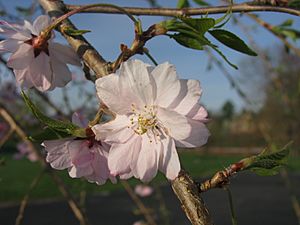Prunus subhirtella 'Pendula' facts for kids
Quick facts for kids Prunus subhirtella 'Pendula' |
|
|---|---|

"Weeping Higan Cherry"
|
|
| Genus | Prunus |
| Species | Prunus subhirtella |
| Cultivar | 'Pendula' |
The Weeping Higan Cherry (also known as Prunus subhirtella 'Pendula') is a beautiful tree known for its unique drooping branches. It can grow quite tall, reaching about 20 to 30 feet (6 to 9 m) high. Its branches can spread out 15 to 25 feet (5 to 8 m) wide, creating a lovely "weeping" shape.
Its leaves are shiny green all summer long. In the fall, they turn a bright yellow before falling off for winter. In the spring, before the leaves even appear, the Weeping Higan Cherry bursts into bloom. It gets covered in light pink, almost white, flowers. This tree is not originally from North America. However, it grows well in many places, especially in USDA hardiness zones 5 through 8.
Contents
About the Weeping Higan Cherry Tree
The Weeping Higan Cherry is a type of Cherry tree. It has a fast growth rate, meaning it grows quickly when it is young. Its branches form a dense crown, which is the top part of the tree with all the leaves and branches. This crown has a special weeping shape, making the tree look like its branches are gently flowing downwards.
Flowers and Fruit
One of the most exciting things about the Weeping Higan Cherry is its amazing flower display in spring. The flowers are about one-inch (25 mm) across. They are a beautiful light pink color, sometimes looking almost white. These flowers make the tree look very showy and pretty.
After the flowers fade, small, oval-shaped fruits appear. These fruits are less than 1⁄2 inch (13 mm) in size and are black. They are not very noticeable on the tree and do not cause a big mess when they fall. However, many animals, like squirrels, deer, and other small mammals, enjoy eating these fruits.
Trunk and Branches
As the Weeping Higan Cherry tree grows, its branches naturally droop towards the ground. Sometimes, these drooping branches might need to be trimmed. This is done to make sure there is enough space for cars or people to pass underneath them. The branches are quite strong and do not break easily. When the tree is young, it is important to prune it. This helps the tree grow a strong structure that will support its beautiful weeping shape for many years.
Common Tree Problems
Weeping Higan Cherry trees can sometimes have problems, especially if the soil is too dry. Here are a few common issues they might face:
- Leaf Spots and Cankers: Tiny red spots can appear on the leaves. These spots might dry up and fall out, leaving small holes. This problem can also affect the twigs.
- Shot Holes: A type of fungus can cause reddish spots on the leaves. These spots also drop out, creating "shot holes" that look like tiny holes punched in the leaves. If this happens, the leaves might fall off the tree. This problem is often worse when the weather is wet.
- Black Knot: This is a disease that causes black, lumpy growths or "galls" to form on the branches.
- Powdery Mildew: Sometimes, a white, powdery coating can appear on the leaves. This is called powdery mildew.

